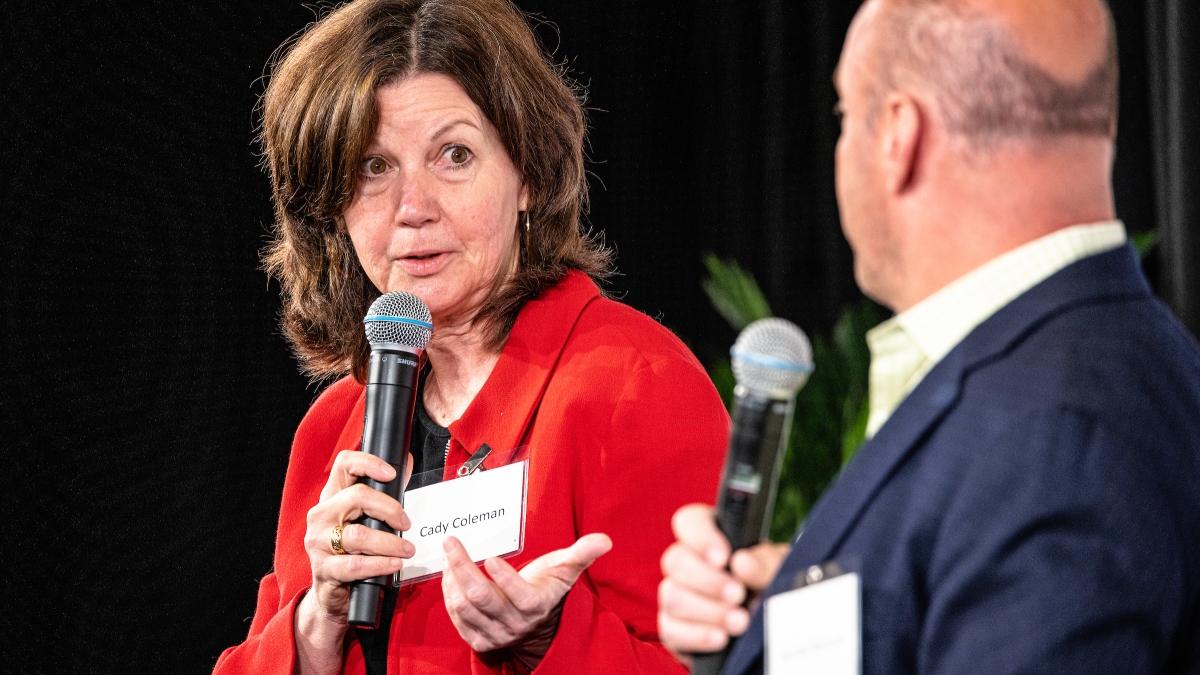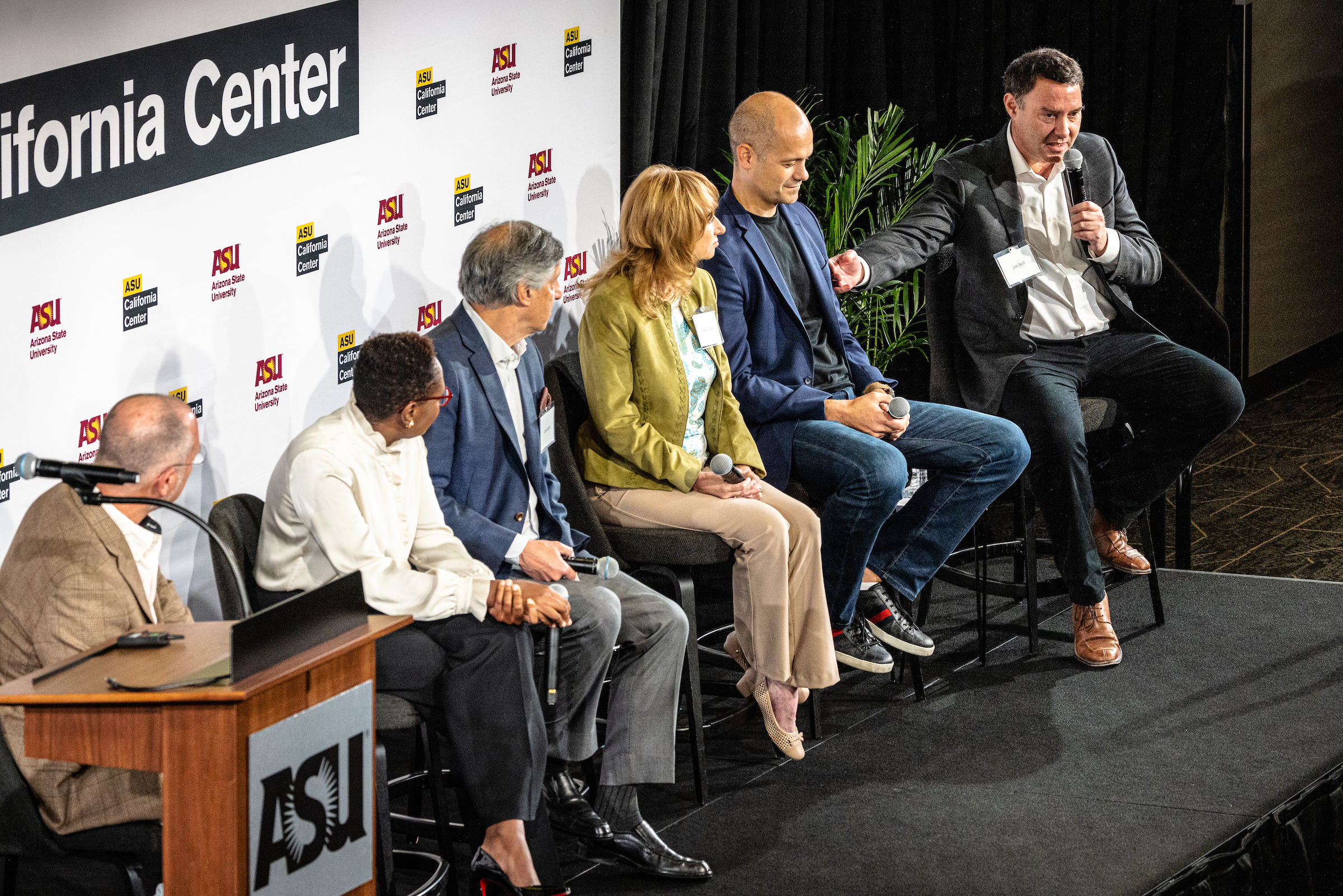Editor's note: This story is part of our coverage of a weeklong series of events to mark ASU's expansion in California at the ASU California Center in downtown Los Angeles.
Former NASA astronaut Cady Coleman said that space travel and the space industry need diversity to succeed.
“We’re not going to be successful if we only have people who look and think alike,” said Coleman, ASU global explorer-in-residence, who gave welcome remarks during the "Space Exploration, Commerce and Stewardship" event that took place at the ASU California Center on Oct. 6.
She’s been working with a group that is seeking to make space accessible to people with disabilities.
“It was eye opening to realize that I’ve been leaving a slew of the population out of my thoughts and ideas,” she said.
“These people are problem-solvers before they get out of bed in the morning. I want to go to space with a problem-solver.”
Coleman noted that the most recent group of people traveling to the International Space Station, who launched on Wednesday, includes two Americans, a Japanese man and a Russian woman.
“Some people think, especially in these times, how can we do that? But that is exactly what space exploration is about,” she said.
“Part of the reason we’re going back to the moon is that it’s not just one country. The way we behaved down here on Earth in terms of resources and countries not getting along and doing things that are not tolerable will repeat itself on the moon if we don’t figure out how to do it.”
Former astronaut Garrett Reisman said that events on Earth influence what happens in space.
“I want that Star Trek future where we can put our differences behind us and all get along, but you can’t ignore what happens on the ground,” he said.
“It’s incongruous to see us hugging each other in space when there are atrocities being committed on the ground.”
Our future in space
ASU Professor Jim Bell (right) speaks in a panel, with (from left) moderator Greg Autry, clinical professor of space leadership, policy and business; Timi Agnanaba, professor of space and society; Lon Levin, vice president of new ventures at Lockheed Martin Space; Rosaly Lopes, directorate scientist for the Planetary Science Directorate; and Josh Brost, vice president of business development at Relativity Space. Photo by Charlie Leight/ASU News
Coleman's remarks were followed by a panel discussion on industry outlooks for our future in space.
Space exploration is much different than when the U.S. and the Soviet Union were racing to the moon in the 1960s, according to the panel of experts who spoke Thursday.
“Returning to the moon is not to repeat the ‘flags and footprint’ mission of Apollo,” said Greg Autry, clinical professor of space leadership, policy and business in the Thunderbird School of Global Management and an affiliate professor with the Interplanetary Initiative.
The nature of the public-private partnerships and the increase in commercial space travel has changed the industry, according to Jim Bell, professor in the School of Earth and Space Exploration and director of the Space Technology and Science (NewSpace) Initiative.
“Our traditional aerospace partners are still there and still involved,” such as Lockheed Martin, he said. “But the new landscape is chock full of entrepreneurial, disruptive small companies that have great ambition and are being seeded with funding by the government.”
Instead of once-in-a-decade, billion-dollar missions, several smaller missions to the moon, Earth orbit and commercial space stations are planned, Bell said.
Josh Brost, who has a degree in aerospace engineering from ASU, is vice president of business development at Relativity Space, a company that is using 3D printing to create rocket parts.
“We’re trying to solve a fundamental problem in all of aerospace, which is that the way we build things makes it too expensive to do new products often, and if you don’t develop new products often, you don’t iterate,” Brost said.
But 3D printing changes that.
“In the public-private partnerships of today, what you’re seeing is no longer putting the financial reward and the financial risk onto one entity,” Brost said.
The new space industry needs all kinds of people to thrive. Timi Aganaba, professor of space and society in the School for the Future of Innovation in Society, is a space lawyer.
“I work with students and companies and all kinds of people talking about the stakeholders. Who are we talking about when we say we need to open up space to everyone? Who has access to financing? Who are the minority stakeholders?
“When it comes to stewardship, space is very individualistic,” she said.
“We’re starting to try to have common understanding, but we’re not there yet.”
Top photo: Professor of Practice Cady Coleman, ASU’s global explorer-in-residence, chats with fellow former NASA astronaut Garrett Reisman, Thursday, Oct. 6, during a session on “Space Exploration, Commerce and Stewardship” at the weeklong event launch of the ASU California Center. Photo by Charlie Leight/ASU News
More Science and technology

ASU researcher part of team discovering ways to fight drug-resistant bacteria
A new study published in the Science Advances journal featuring Arizona State University researchers has found vulnerabilities in certain strains of bacteria that are antibiotic resistant, just…

ASU student researchers get early, hands-on experience in engineering research
Using computer science to aid endangered species reintroduction, enhance software engineering education and improve semiconductor material performance are just some of the ways Arizona State…

ASU professor honored with prestigious award for being a cybersecurity trailblazer
At first, he thought it was a drill.On Sept. 11, 2001, Gail-Joon Ahn sat in a conference room in Fort Meade, Maryland. The cybersecurity researcher was part of a group that had been invited…

